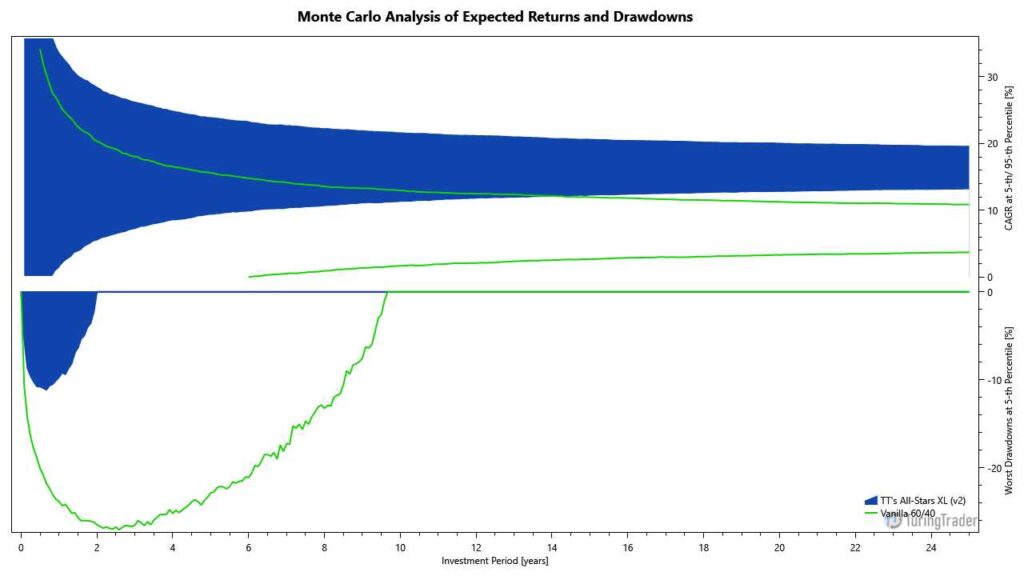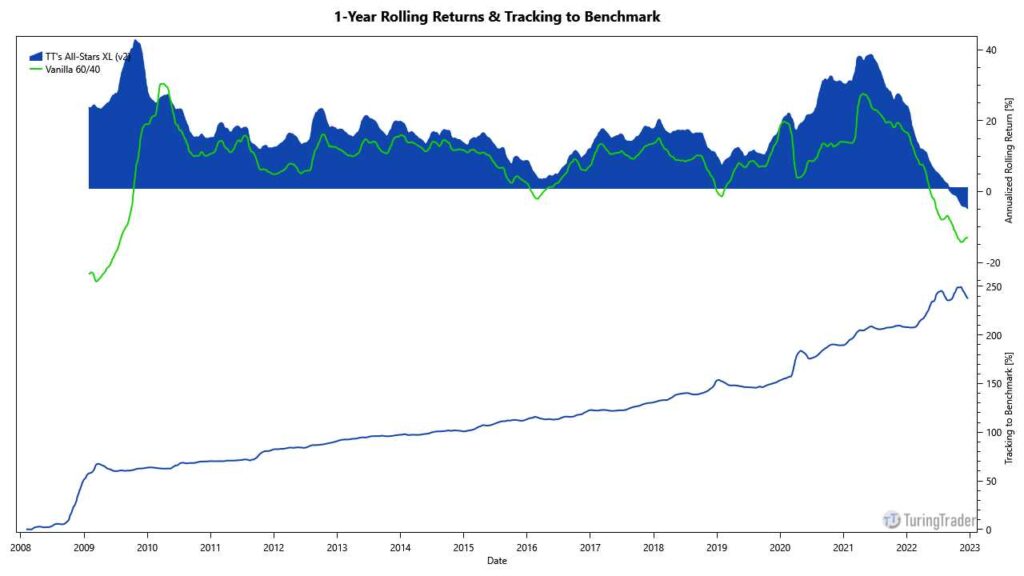Summary
This strategy is outdated and requires improvements to better cope with environments of rising bond yields. In the meantime, we suggest using VIX Spritz as a replacement.
- Objective: balanced growth
- Type: volatility-targeting strategy
- Invests in: ETFs tracking industry sectors, treasuries
- Rebalancing schedule: weekly
- Taxation: 80% short-term capital gains
- Minimum account size: $12,000
Equal Voltage is a proprietary premium strategy by TuringTrader.com, introduced in November 2019.
Equal Voltage aims to provide stock-like returns, with a volatility comparable to a passive 60/40 portfolio. To achive its objective, the stratregy invests in a menu of 11 S&P 500 sector ETFs, using volatility targeting to determine the exposure. Excess capital is invested in U.S. treasuries as a safer alternative.
Equal Voltage requires only little maintenance, thanks to its weekly rebalancing schedule.
Performance
This table shows the portfolio’s key performance metrics over the course of the simulation:
The following chart shows the portfolio’s historical performance and drawdowns, compared to their benchmark, throughout the simulation:
This chart shows the portfolio’s annual returns:
The following charts show the Monte-Carlo simulation of returns and drawdowns, the portfolios 12-months rolling returns, and how the portfolio is tracking to its benchmark:


Asset Allocation
The portfolio last required rebalancing after the exchanges closed on @last-rebal@. Due to fluctuations in asset prices, the exact allocations vary daily, even when no rebalancing occurred. The current asset allocation is as follows:
Sign up for our FREE Basic membership to see the asset allocation.
Sign up for our FREE 14-day trial to see the asset allocation.
Strategy Rules
The operation of Equal Voltage can be summarized as follows:
- weight 11 sector indices inversely to their historical volatility
- invest any unused capital in U.S. treasuries
These rules reflect the idea that in the long run, the U.S. stock market provides the best growth opportunities. Volatility poses the biggest threat this growth, which is addressed through reducing exposure in times of increasing volatility. We encourage investors keen on learning more about this rationale to read our article regarding volatility targeting.
Diversification
The strategy is well diversified in terms of individual titles, as it only invests in broad indices. Equal Voltage‘s low beta suggests the strategy being also well-diversified across asset classes. However, in times of low volatility, the strategy may allocate up to 100% of its capital toward the stock market, resulting in a tail risk similar to holding the S&P 500 index, should volatility spike rapidly.
Returns & Volatility
Like many active strategies, an essential part of returns stems from losing less than passive portfolios during recessions. Therefore, Equal Voltage‘s returns should be contemplated over the full economic cycle.
The strategy beats a passive 60/40 in most years and managed the 2008 recession exceptionally well. However, it missed out on most of the 2009 rebound. Equal Voltage‘s maximum drawdown is less than that of a passive 60/40, but slightly amplifying short-term volatility. Overall, Equal Voltage has shown docile behavior throughout the past economic cycle and has beaten both the 60/40 benchmark and the S&P 500 by a wide margin.
The Monte-Carlo simulation confirms these observations: Equal Voltage has a solid upside over a 60/40, while offering a comparable risk profile.
Account & Tax Considerations
When the strategy adjusts its sector exposure, it triggers taxable events. However, a significant portion of the portfolio’s assets is held for several years, qualifying for long-term treatment of capital gains. From the tax perspective, we see Equal Voltage roughly on par with a 60/40 portfolio. This makes it a great candidate for taxable accounts.
The strategy invests in up to 12 ETFs at a time. Therefore, it requires a minimum starting capital of $12,000.


